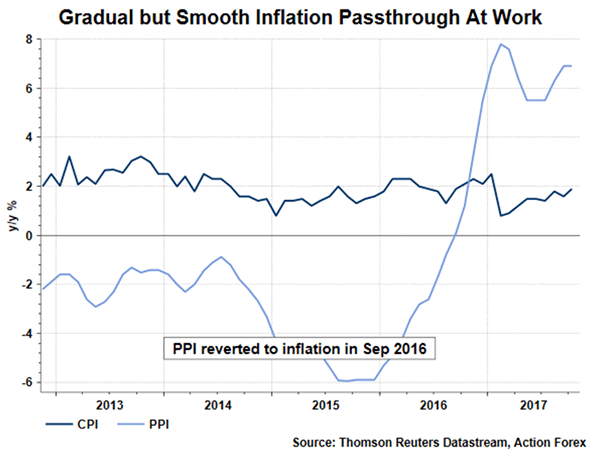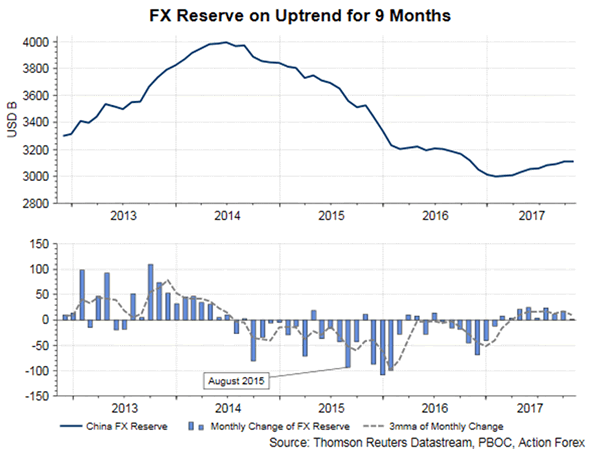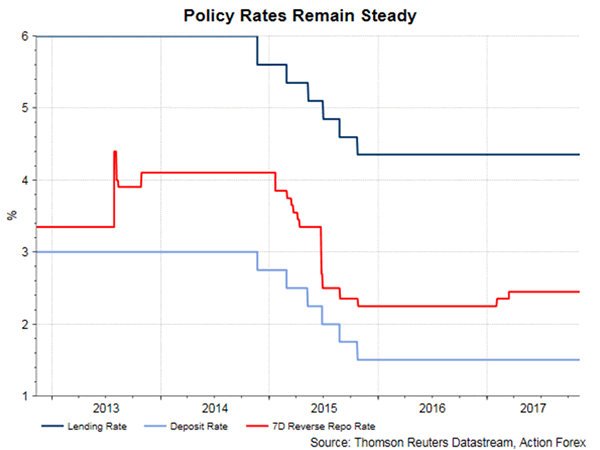China inflation, both upstream (PPI) and downstream (CPI), surprised to the upside in October. Headline CPI accelerated to +1.9% y/y, from +1.6% in September, beating consensus of +1.7%. Food deflation improved to -1.4% y/y in October, from September’s -1.4%, whilst non-food price steadied at +2.4% y/y. Core CPI also steadied at +2.3% last month. PPI stayed unchanged at +6.9%, beating expectations of a slowdown to +6.9%. The set of data indicates gradual but smooth pass-through of inflation (from PPI to CPI), thanks to stable wage growth and improved capacity utilization. Headline CPI has a chance of rising to +2% by year-end and exceeding it in 2018. Note, however, that the upper bound of PBOC’s inflation target is +3%.

Foreign Trade
China’s trade surplus widened to US$ 38.2B in October from US$ 28.5B a month ago. Yet, this came in lower than consensus of US$ 39.5B. Exports growth eased to +6.9% y/y while imports growth moderated to +17.2% from +18.6% a month ago. The data indicated that exports growth probably has peaked in the middle of the year and the slowdown should continue towards winter time. China’s trade surplus with the US declined to US$26.6B in October (second high on record), from US$ 28.1B a month ago. In the first 10 months of the year, the trade surplus with the US was about US$ 223B. We find it sarcastic that US President Donald
Trump is celebrating the signing of a trade deal worth of US$ 250B with China. He even dismissed previous blames on China regarding the huge deficit the US has been suffering. He appears to have overlooked the fact the trade deal is actually worth less one year’s trade deficit against China.
Returning to China’s trade data, growth in commodity imports decelerated across the board. For instance, iron ores imports grew +1.6% y/y, down from +10.6% a month ago, steel products imports contracted -12%, after gaining +9.7% in the previous month. All in all, commodities contributed 3.4 percentage point to imports growth, almost halving the 6.2 percentage point in September. This probably indicated decline in domestic demand.

FX Reserve
Extending the rising streak for a ninth month, China’s FX reserve increased +700M to US$ 3.109 trillion in October. The increase came in less than expectations and September’s +US 17B. The government has diminished intervention in the FX market as capital flow stabilized, as a result of steady renminbi movement and the government’s stringent capital control measures.

Monetary Policy
The October data released so far should not alter PBOC’s monetary policy. While inflation has been rising, the risk of overshooting is low. As mentioned above, unlike other major central banks where their inflation target is usually at +2%, PBOC is not expected to alter its monetary policy to a tighter side just because inflation is persistently above +2%. That said, China’s interbank market rates are usually higher towards the year-end. Together with the likely Fed funds rate hike in December, we are foreseeing upward pressure on China’s interbank rates.













